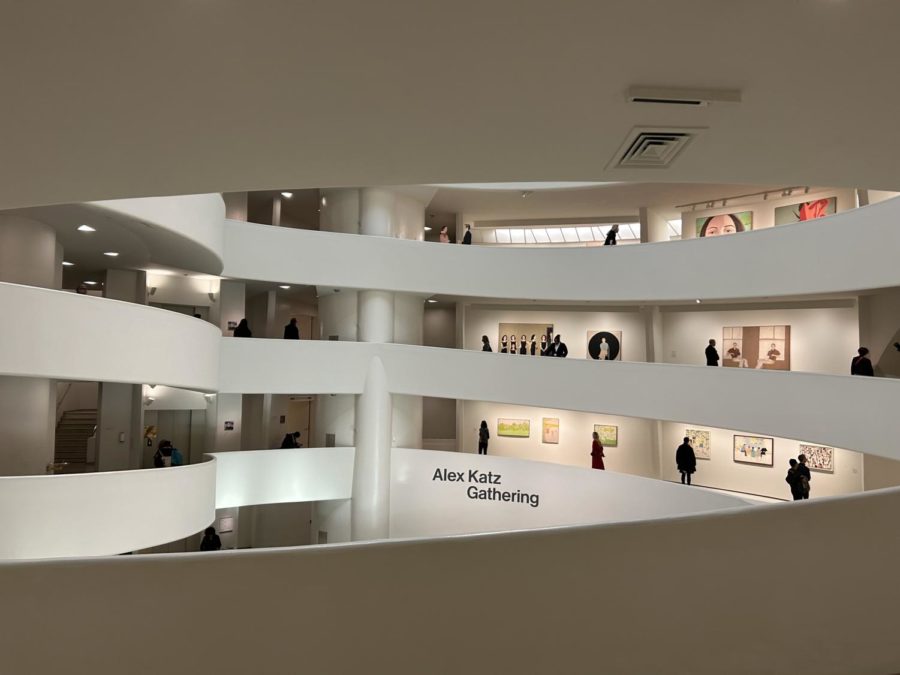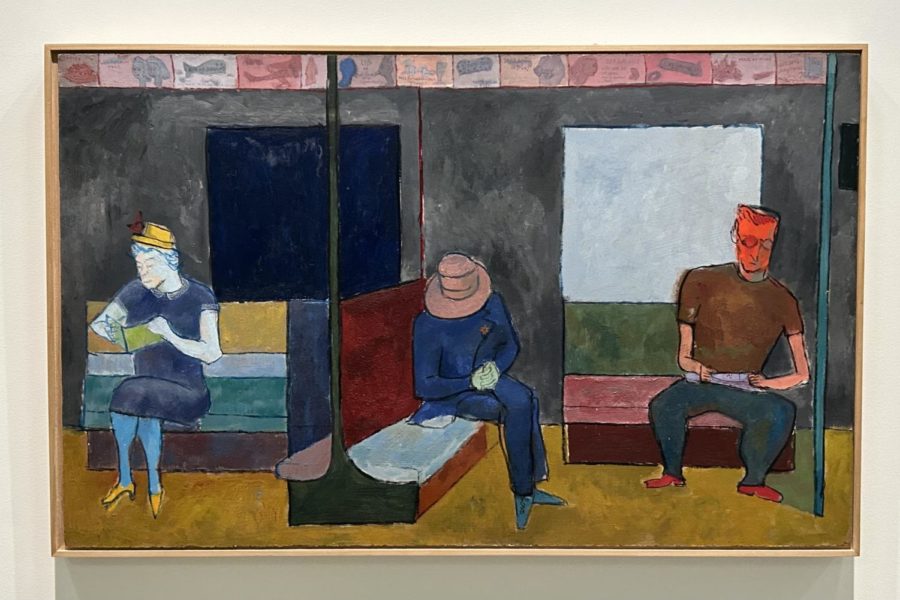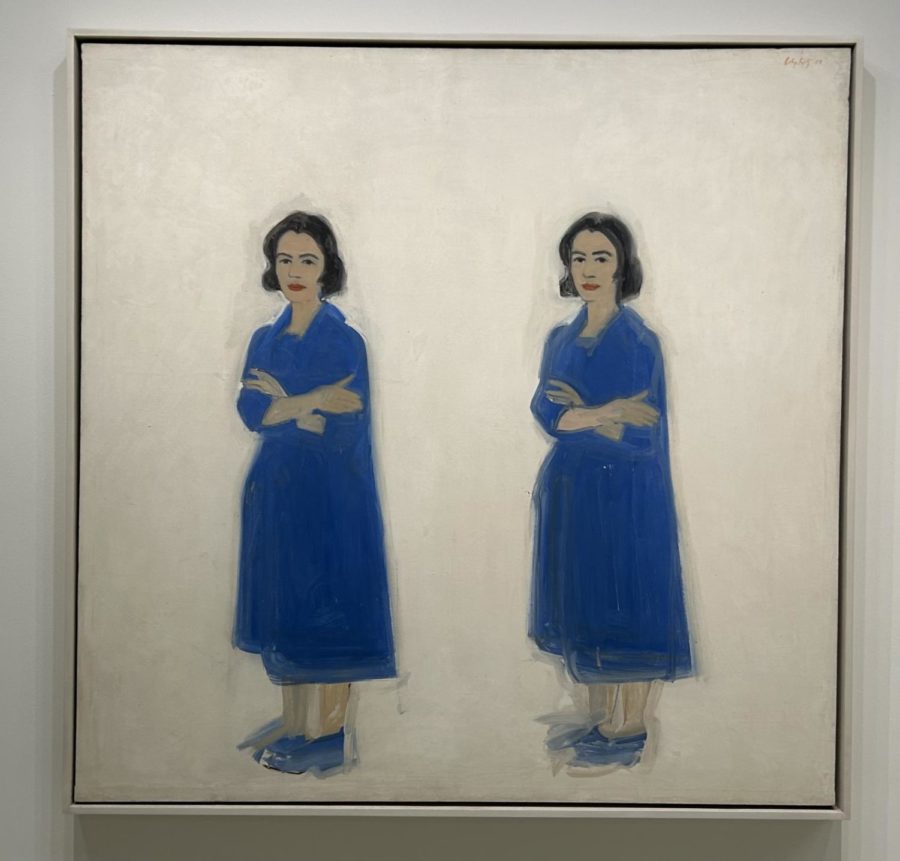An Ode to Alex Katz: The Guggenheim’s ‘Gathering’ and Beyond
Being a city rife with life, the soul of New York is near impossible to summarize on a two-dimensional canvas. In his Guggenheim exhibit and beyond, however, Alex Katz manages to defeat these odds with the stylistically distinct stroke of a brush.
‘Gathering’ was on display in the Guggenheim Museum in New York City and featured many works by Alex Katz.
The work of artist Alex Katz lined the towering spiral that is the Guggenheim’s rotunda, but the pieces themselves are anything but. Katz’s signature – placid portraiture – recounts his upbringing and career in New York City through paintings purposefully lacking in dimension. It is through these flat surfaces that he ironically narrates the depth of his story.
Born in 1927 Brooklyn to two Russian-Jewish émigrés, Alex Katz was exposed to a world of culture from an early age. He was raised in St. Albans, a suburb of Queens, New York, which was home to a vast immigrant population.
Like many city-goers today, Katz often struck inspiration in his commute, observing passerby along the way from St. Albans to his school in the East Village. It was these train rides that likely influenced Three Figures on a Subway, completed in 1948. The work is colorful, geometric, and almost symmetrical, marking the beginning of what would later become a hallmark of the artist’s style.
In the following two years, Katz spent his summers finding solace in what was the polar opposite of his usual city setting. Funded by the Skowhegan School of Painting and Sculpture, he captured the lush landscapes of Maine in a series of oil sketches. There, he adopted a reverence for natural light, and reflected his observations in many monochrome pieces that highlighted only the role of sunlight.
Among these is Golden Image, a 2017 painting featuring various hues of yellow. Golden Image depicts the ubiquity of the light pouring through the wooded pines surrounding Katz’s Maine cottage. The work differs from the immediacy that is common in many of the artist’s oeuvres: “I usually paint the sensation of what I’m seeing,” said Katz. “Here, I’m actually painting the analysis of it, all memory.”
The pattern of landscape likenesses endured throughout the 1950s, eventually metamorphosing into loose sketches with more concrete subjects. American painter Milton Avery heavily inspired this shift, renowned for his semi-abstract forms and distinct color palette that Alex Katz would later minimic in pieces such as Lake Time. The 1955 painting tells the story of a social setting using soft, blended colors, evoking a sense of reverie-like radiance.
Such integration of people as subjects blossomed into Katz’s distinct knack for portraiture by the latter half of the 50s. Featured were friends of his; the prominent poets, painters, and dancers of the time. The most recurring of his sitters was Ada Del Moro, who would later become his wife and mother to their son, Vincent Katz.
Frank O’Hara, famous poet and friend to the artist, describes Ada’s presence in her husband’s art as “a role as abstract as that of Helen of Troy; she is a presence and at the same time a pictorial conceit of style.”
She appears in the aptly titled 1959 painting Ada Ada, whose palindromic name parallels the painting’s symmetry. The same image of a cross-armed Ada appears on both sides of the canvas, creating an almost photographic frame as opposed to capturing a more lively, infinite moment.
This duplication is upstaged by the sixfold multiplication of Ada’s figure in The Black Dress, dated 1960. She dons a simple black dress that is symbolic of her sophistication, and strikes six different poses, implying motion at the request of Ada herself. “Ada has always been fascinated by cinematic gestures,” said Katz. “All of these gestures are Ada’s decisions, not mine.”
Movement also became a key concept in Paul Taylor Dance Company. The company’s 1963 rendition of Scudorama, for which Katz designed the costumes and sets. He, alongside Taylor, utilized gaudy colors in juxtaposition with the bleak nature of the dancers’ motion, positioning the scene before a monochrome background of a deep purple in order to combine these two elements.
A less choreographed form of movement inspired The Cocktail Party two years later. Katz was fascinated by the rearrangement of groups over time as interactions between individuals were crafted, inviting friends to his loft residence by Madison Square Park in order to observe these trends firsthand. Individuals such as painter Yvonne Jacquette, poet Bill Berkson, and writer Edwin Denby were drawn as they mingled in the apartment with no detail of their appearance spared.
This motif of social perception became a common theme in Katz’s works. One of his few self-portraits – Track Jacket, 1956 – draws attention to his clothing rather than his identity. The casual style is purposefully selected to portray its wearer as an on-trend and youthful as opposed to the more traditional perception of a stoic artist. It is emblematic of the artist’s desired social standing.
From his fascination with this element of culture emerged a style that the Guggenheim Museum describes as “pair[ing] the powerful formal strategies of abstract painting with an equally electrifying visual language of mass culture, immersing the viewer in a burst of optical intensity.”
A new artistic era for Katz thus began. As was especially true in the 1960s, his intended audience was the trained eye. He intended for onlookers to already be familiar with famous films and photographs, catering specifically to those who would be able to connect a painting of his to a wider artistic epoch.
During this time, the artist began opting for larger-than-life canvases. Katz cropped his works in ways that recreated the up close and personal nature of a simplistic human interaction, mimicking the view of a zoomed-in camera or the gaze of someone encountering the subject. In this sense, “Alex Katz has a unique ability to take simple, mundane interactions – people walking, talking – and bring their seeming insignificance to life,” said Carson Michel ’23.
One piece which most notably utilizes this perspective is The Red Smile. The 1963 oeuvre amplifies Ada’s profile against a bright red background, creating a stark contrast against her pale skin. Her pose, a seductive smile, was most commonly found in pop culture magazines at the time, intertwining facets of mass media imagery with conventional portraiture.
The large scale of The Red Smile, among others, was inspired by Katz’s reverence for billboard advertisements. “I love the scale of billboards, the romance of billboards, and the bluntness of them,” he said.
By the 1980s, Katz shifted back to landscape scenes sans human subjects. He depicted both urban and natural scenes, reducing their initial intractability into a pensive serenity. This style persisted for many decades; Sunrise, completed in 2019, encapsulates it perfectly.
Bright orange and pale blue light filter through an abstract array of tree branches, painted using forceful brushstrokes that call attention to the physical interaction between a canvas and its artist. The gusto that characterizes this relationship in the creation of Sunrise was inspired by Jackson Pollock, whose famous “drip technique” paintings demanded similar levels of vigor.
The Guggenheim exhibition, which ran from October 21st, 2022 to February 20th, 2023, did an excellent job of featuring this era of Katz’s work at the very end of the show, establishing a chronology that allows onlookers to visualize the evolving mind of the artist. Though this stylistic change is evident in the content of his paintings, certain stylistic elements became slightly redundant.
The flatness to each and every Katz portrait, for example, was somewhat successful in mimicking a moment in time, yes, but hampered the flow of the story told by the exhibit. Walking through the Guggenheim’s rotunda was reminiscent of flipping through a picture book, rather than watching a fluid narrative of Alex Katz’s life.
Nonetheless, the exhibition told a scintillating story. Meditative and profound, the works of Alex Katz are a beacon of artistic innovation.
Katz’s signature – placid portraiture – recounts his upbringing and career in New York City through paintings purposefully lacking in dimension. It is through these flat surfaces that he ironically narrates the depth of his story.
Sela Emery is a Copy Chief for 'The Science Survey.' She focuses on art history, covering relevant art pieces and exhibitions with each issue. In addition...













